Home > Non-Decimal Calculators > Weight Calculators
Imperial-Weight Calculators
The Imperial weight units were (and still are to a very limited extent) used in Britain and its former colonies. The units work like this:
One Ton = 20 Hundred-weights (cwt.) [= 2240 Pounds (lbs.)]
One Hundred-weight (cwt.) = 4 Quarters (qtr.) [= 112 Pounds (lbs.)]
One Quarter (qtr.) = 28 Pounds (lbs.)
One Stone (st.) = 14 Pounds (lbs).
One Pound (lb.)
= 16 Ounces (oz).
On this page are several "Comptometer" type calculators made for operating with units of this complicated system:
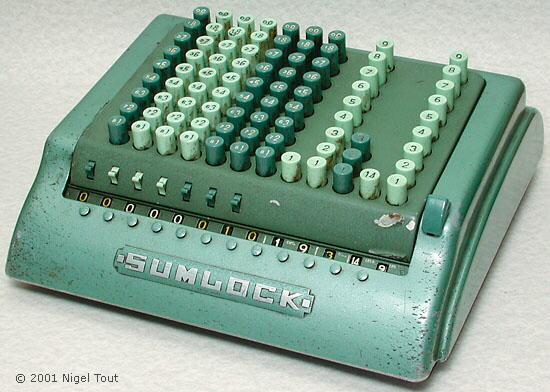
Sumlock Imperial-Weight "Comptometer".
This is a direct action keyboard calculator of the "comptometer" type with a keyboard for calculations in Imperial weight units (model SUMLOCK 912/Y/122703, made by Bell Punch Co. Ltd. in Britain, distributed by Sumlock Ltd., both owned by Control Systems Ltd.).
330 mm x 315 mm x 135 mm (13" x 12.5" x 5.5"), 7 Kg (15.5 lbs).
Manufactured about the 1950's-1960's.
The keyboard of this machine (see below) has keys with, from the left, 7 columns of Tons keys, 2 columns for Hundred-weight keys, 1 column of Quarters keys, and 2 columns for the Pounds keys.
Yes, the single key in the second
column from the right has "14" on it, which is the number of Pounds in one Stone. The value in this column has to be mentally added to the number in the right-most column. There is carry over when this sum reaches 28
into the third column from the right (ie. Quarters).
The machine in the photograph displays the total of 10 Tons, 19 Hundred-weights, 3 Quarters, and 23 Pounds.
For information about the Bell Punch company and its calculators see the article on this site "Anita: the world's first electronic desktop calculator - A brief history of the complex Bell Punch company and its calculators".
For a detailed history of the development of the Bell Punch and Anita calculators go to the associated site "Bell Punch Company and the Anita Calculators".
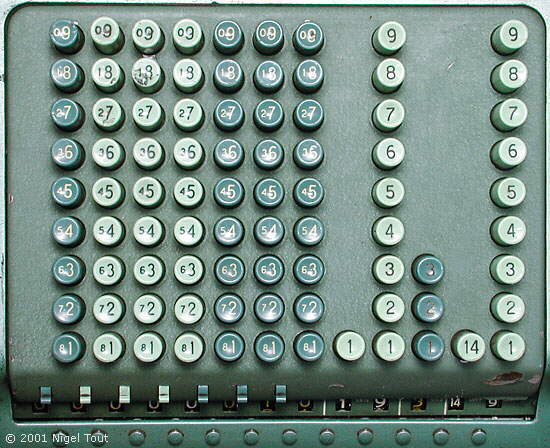
The strange keyboard of this Imperial weight calculation machine.
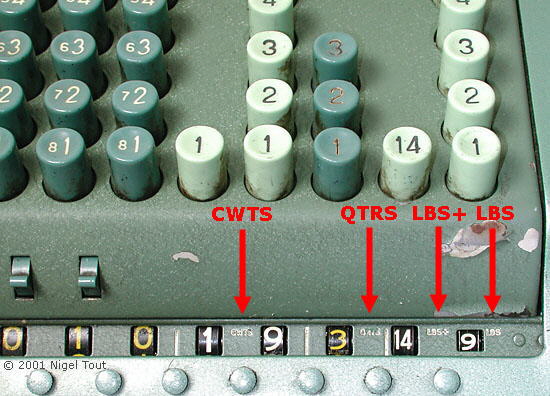
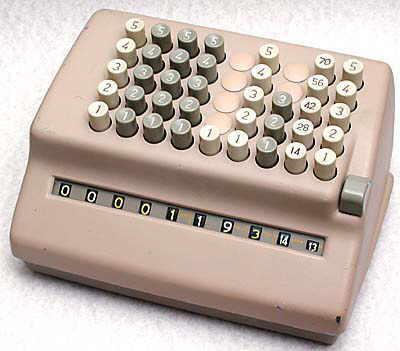
Plus Imperial-Weight abbreviated "Comptometer".
This is a direct action keyboard calculator of the "comptometer" type with an abbreviated keyboard for calculations in Imperial weight units (model PLUS 509/Y/876.514, made by Bell Punch Co. Ltd. in England, distributed in U.K. by Sumlock Comptometer Ltd., both owned by Control Systems Ltd.).
241 x 182 x 177 mm (9.5" x 7.2" x 7.0").
Manufactured about the 1960's.
This is a slightly later model than the one above, both by the Bell Punch Company. It has an abbreviated keyboard - it only has keys 1 to 5 in the standard decades columns, so to enter a number greater than 5 you have to press one key followed by another which add up to the number required.
The machine in the photographs displays the total of 1 Ton, 19 Hundred-weights, 3 Quarters, and 27 Pounds.
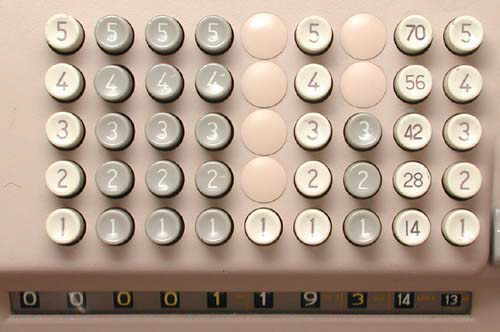
Close up of the keyboard of this imperial-
weight calculator.
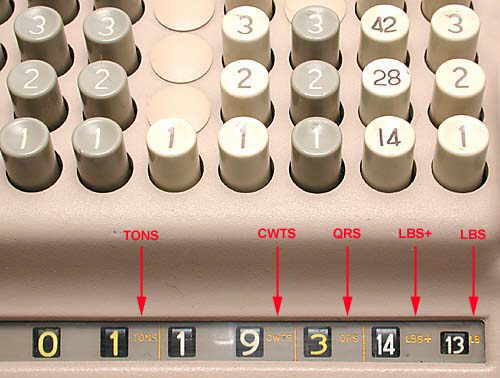
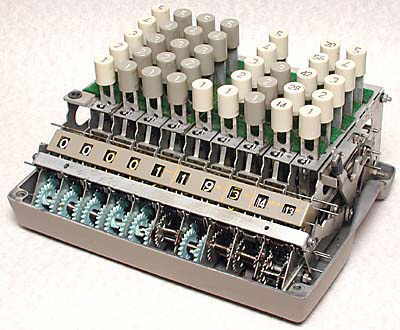
With the cover removed. The standard, decimal columns use plastic gear wheels, while the non-standard columns use metal gears. It was probably not economical to make the moulds for these non-standard items.
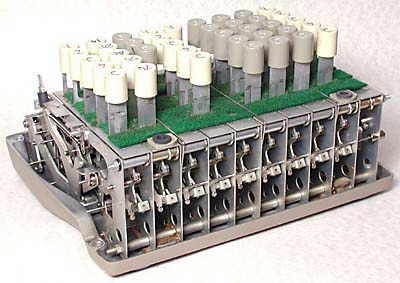
With the cover removed, from the rear.
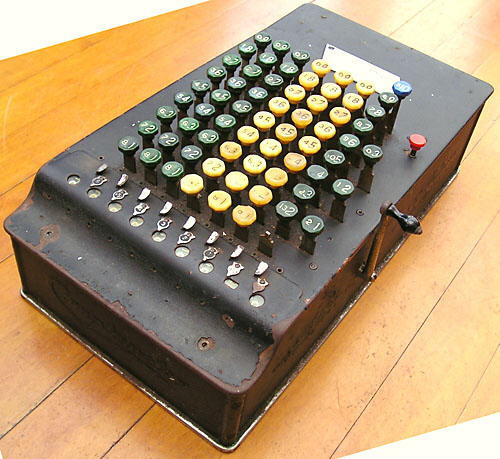
Comptometer Imperial-Weight abbreviated.
This is a model J Comptometer with a keyboard for calculations in Imperial weight units (serial No J288966), made by Felt & Tarrant Manufacturing Co. in the USA in the 1920s - 1940s.
The Comptometer model J was very successful and tens of thousands of the decimal and Sterling currency (£sd) versions were built between the 1920s and 1940s. The version illustrated here is very unusual since it apparently
has a keyboard for adding in pounds and ounces, where 16 ounces = 1 pound.
This type of machine is primarily used for addition and subtraction.
The keyboard (see photograph below) has 8 columns of keys which from right to left are: 1 column with 3 keys for quarters of ounces, 1 column with 10 keys for ounces, and 6 columns of 9 keys for pounds. Since the ounces column
is abbreviated to 10 keys, rather than 15, to enter a number between 11 and 15 the operator has to press one key and then another which total to the number required (for example to enter 13, press 6 then 7).
Note that there are
2 numbers marked on each key -
- The larger one is used for addition.
- The smaller one is used for subtraction using the "9's complement" method (or in the case of the ounces column "15's complement").
An excellent source of information on Felt & Tarrant Comptometers is at http://www2.cruzio.com/~vagabond/ComptHome.html
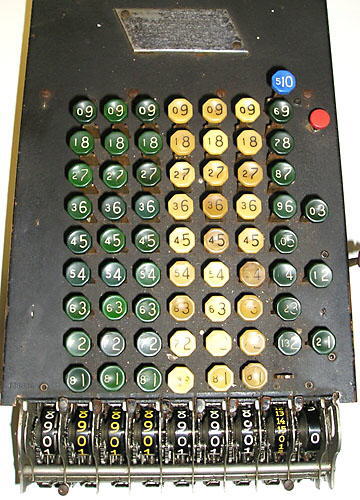
In this close-up the front cover has been removed to reveal the numbered accumulator reels.
The reel second from the right has numbers 0 to 15. This is for accumulating the total of ounces and carries over to pounds at 16 (16 ounces = 1 pound).
The reel on the far right has numbers 0 to 3 for accumulating the total of quarters of an ounce.
The 6 reels on the left have numbers 0 to 9 for accumulating the total of pounds.
The 2 numbers on each key can be seen where -
- The larger one is used for addition.
- The smaller one is used for subtraction using the "9's complement" method (or in the case of the ounces column "15's complement").
Fortunately, Britain changed to the metric system during the 1970s and 1980s and this complicated system of units is now virtually obsolete. It does not appear to have been used in modern times in the U.S.A. where weights are
customarily given in Pounds (lbs) only.
No electronic calculators are known to have been sold which use this weight system, though a Sumlock-Anita engineer says that he was involved in the modification of some ANITA electronic
calculators to this system for Britain's National Coal Board in the late 1960s.
There are instructions for the basic use of Comptometer-type machines in the article "Operating a Comptometer" on this site.
For information about the Bell Punch company and its calculators see the article on this site "Anita: the world's first electronic desktop calculator - A brief history of the complex Bell Punch company and its calculators".
For a detailed history of the development of the Bell Punch and Anita calculators go to the associated site "Bell Punch Company and the Anita Calculators".
Click here for more information about Comptometers.
Non-decimal calculators
Vintage Calculators
© Text & photographs copyright Nigel Tout 2000-2021 except where noted otherwise.